The ADA ramp at SW Spring and 16th Streets was torn down Wednesday and will be rebuilt a fourth time. We profiled this corner the day before as an example of ongoing construction problems with new ADA ramp requirements triggered by the Bureau of Environmental Service’s (BES) Goose Hollow Sewer Repair Project.
In addition to the Spring Street ramp (above), the newly built ramp at the corner of SW Montgomery Dr and Roswell Ave was also demolished this week.
BikePortland reached out to BES for help in understanding why these builds have been so problematic. Aaron Abrams, the Community Outreach Program Manager at BES responded this morning:
Thanks for your article about the ADA ramp at SW 16th and Spring… Work at this location has proved to be challenging for the City and the contractor. The varying slopes at this corner have led to some struggles in meeting ADA specifications.
Ultimately, completing work at this location is the contractor’s responsibility; however, the City is working closely with the contractor to make sure the ramps meet ADA specifications according to PBOT standards… The contractor is required to meet design specifications that comply with federal requirements for the ramps. BES will only be paying the contractor for finished work that passes inspection. We will not be paying for attempts that don’t meet standards. Ultimately, BES ratepayers will only pay for a product that meets federal requirements and has been approved by the City. We understand how this work has disrupted that location and are confident that as we work with the contractor going forward, work will be completed successfully to restore that corner.
Yesterday I happened by the Roswell ramp pictured above while crews were completing the form for the new concrete pour. A PBOT employee was present as the group checked the slopes of each element of the form. There was a surveying tripod across the street. Clearly it was exacting work.
I also noticed at both the Roswell Avenue and Spring Street locations that the initial design of a single ramp on the diagonal had changed in subsequent builds to separate ramps for each street, in other words, two ramps per corner. A Directive from the City Engineer addresses the one versus two ramp design issue:
The City’s preference is to build two single curb ramps at a corner, rather than one diagonal ramp. However, FHWA provides for a variety of curb ramp types and configurations. Constructing one diagonal curb ramp at a corner instead of two single ramps at a corner constitutes a variance from the City’s criteria and requires approval of the PBOT ADA Technical Advisor.
Hopefully next week’s builds will be a wrap.


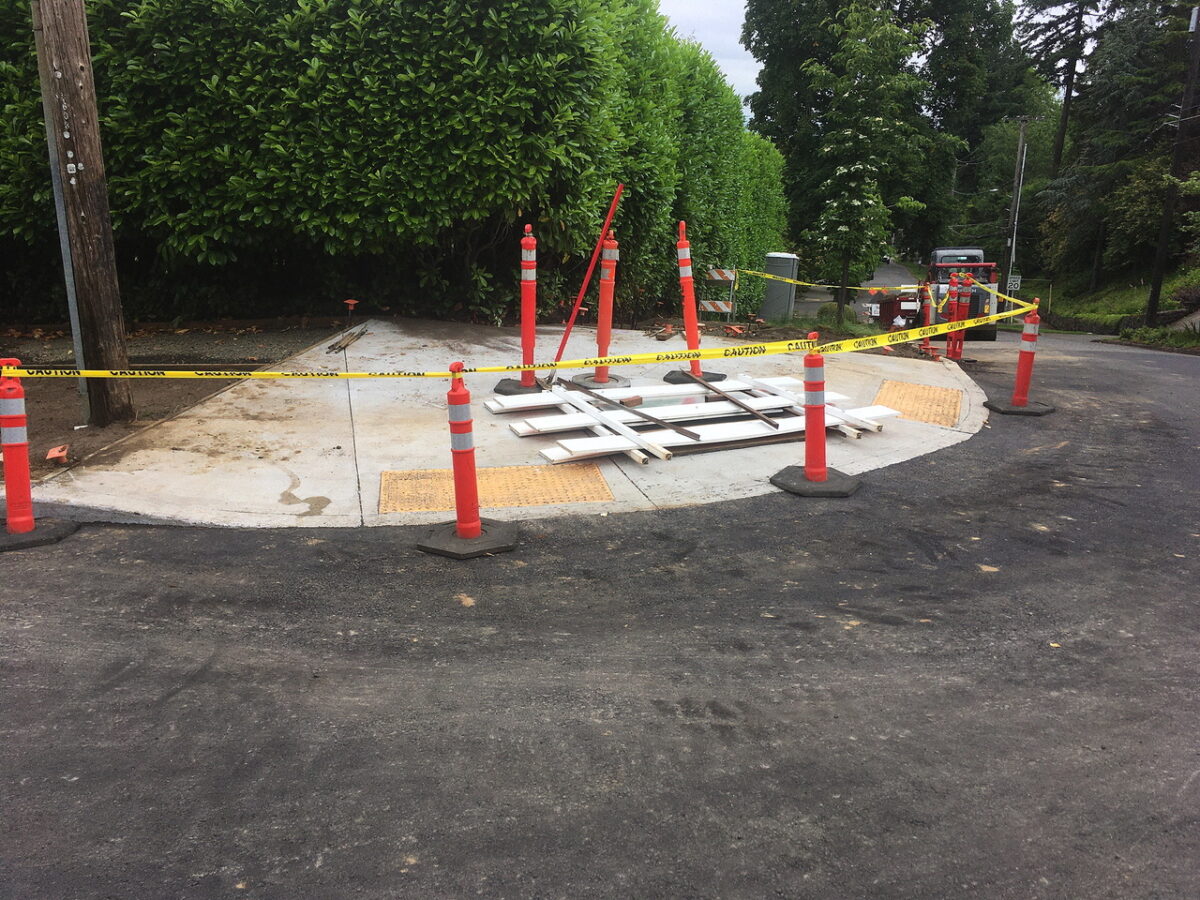
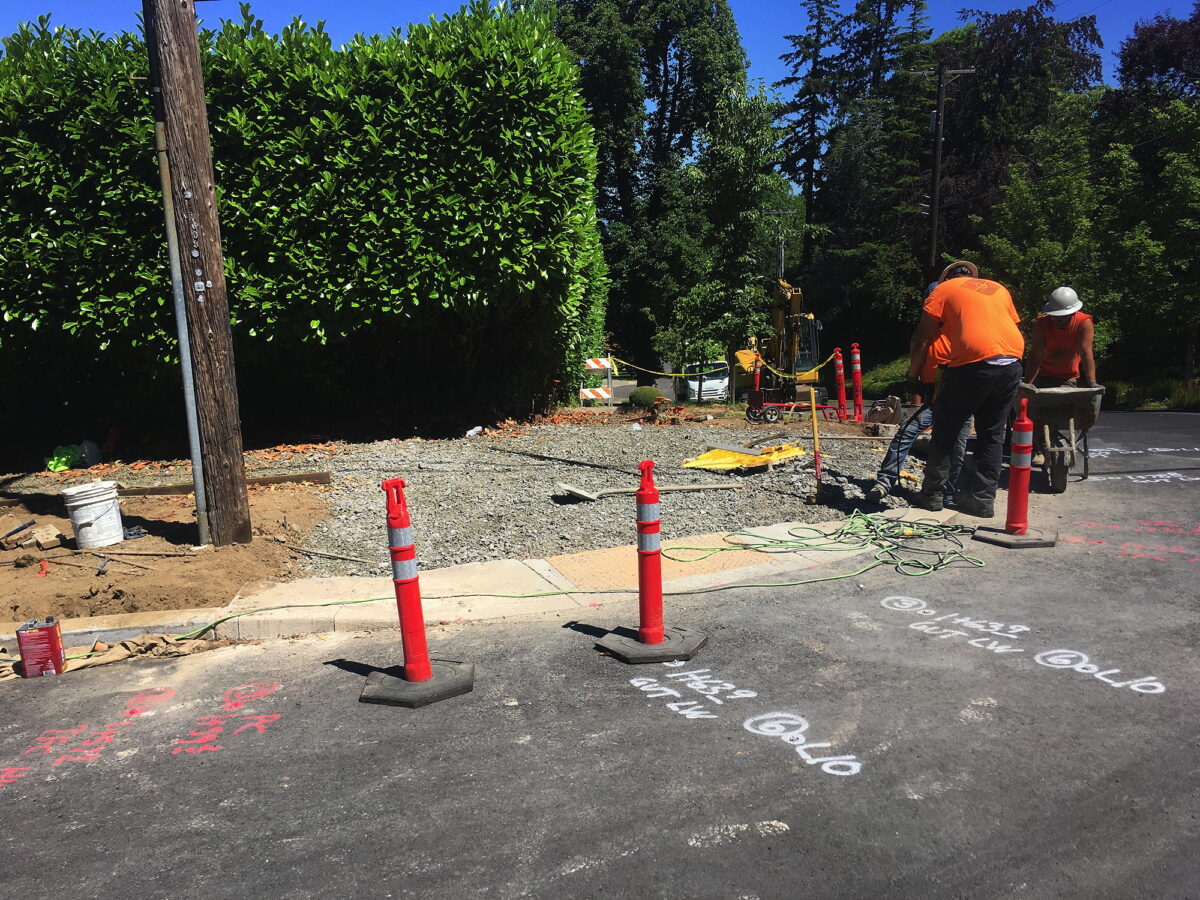
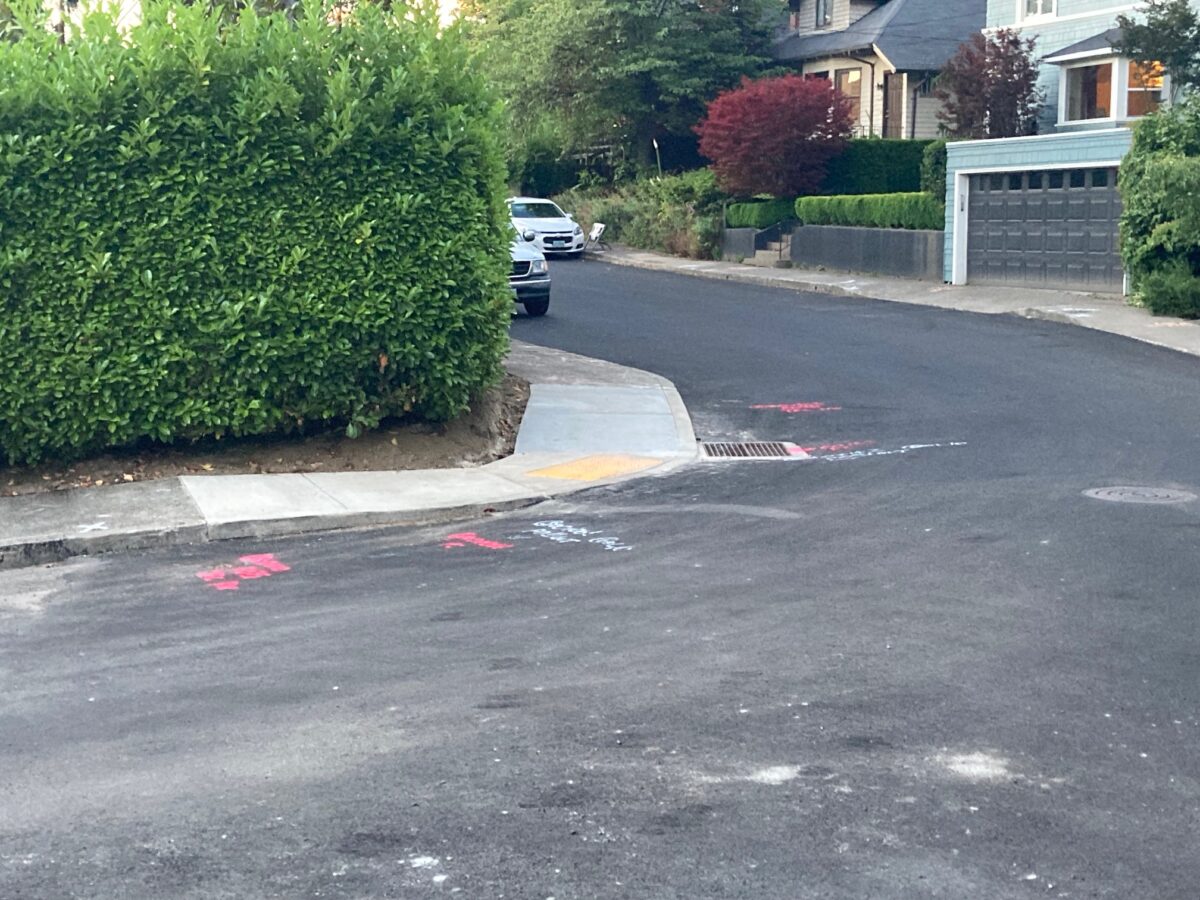
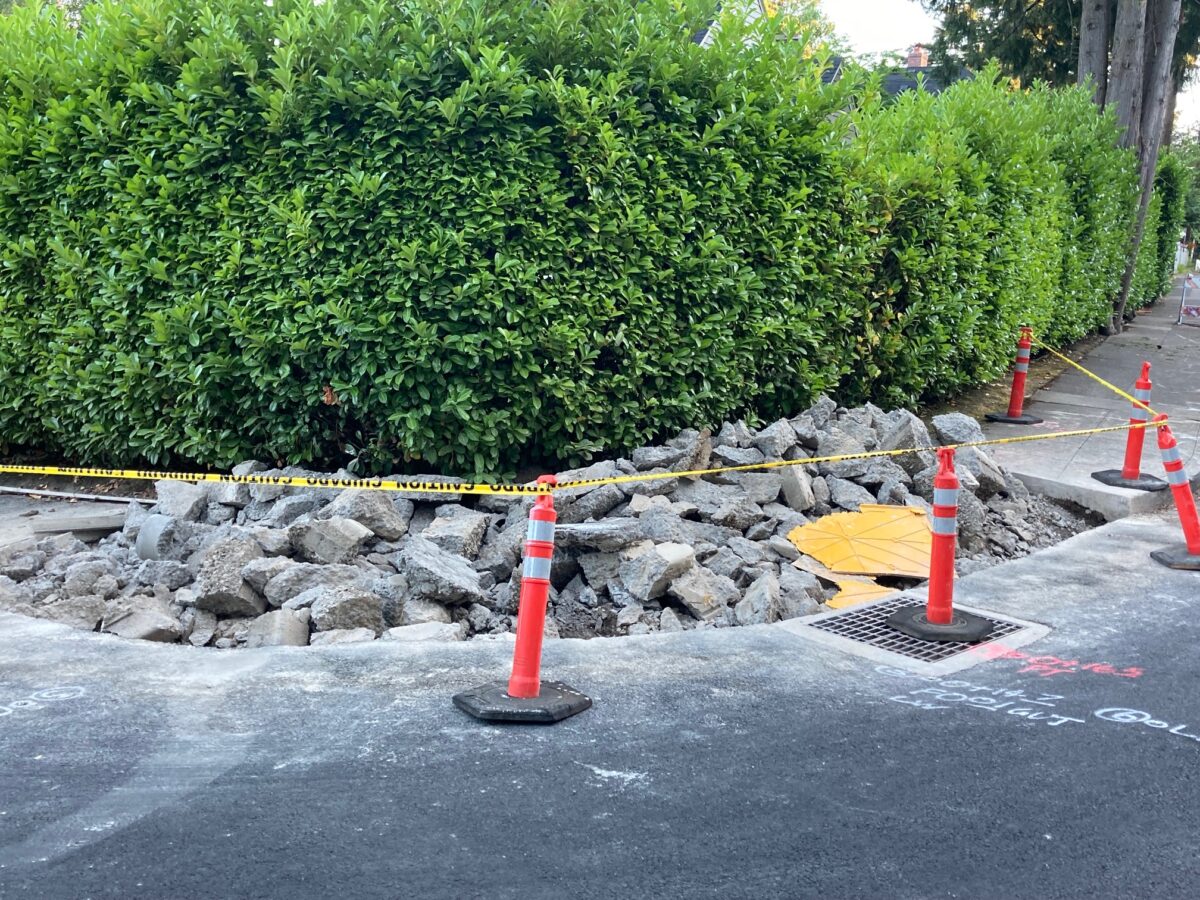

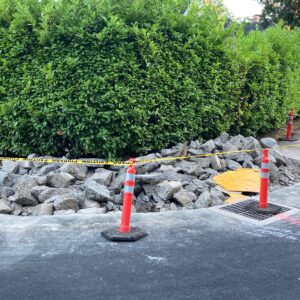


Thanks for reading.
BikePortland has served this community with independent community journalism since 2005. We rely on subscriptions from readers like you to survive. Your financial support is vital in keeping this valuable resource alive and well.
Please subscribe today to strengthen and expand our work.
I’m an engineer who has helped design and oversee the construction of ADA ramps and various intersection projects when traffic signals are installed. I’ve also worked on a concrete crew when I was going to college. Unless you’ve been involved in both, I don’t think you can fully appreciate the complexity of designing and building ADA ramps in the real world – as opposed to drawing them on paper. It’s a three-dimensional puzzle. Not only do you have to meet the 1:12 maximum slope, you have to assure that the cross slope is less than 2 percent (1:50), and you have to provide adequate drainage, which requires a minimum slope of 2 percent, and you have to install the mats of truncated domes for the seeing-impaired persons. And you have to match up the ramp with the adjacent street and the sidewalk in both directions. And there are storm drains and the manholes into which they feed.
And when concrete is poured, it’s really tough to get the exact height on a surface that’s sloping in two directions at once. A quarter-inch disparity at one corner at the back of the ramp can throw off the ramp, the approach, or the side slope, causing it to be out of compliance.
Sure, the city is paying only for the completed project and not the previous three attempts, but you can be sure that all contractors put enough cushion in their bids to cover some redo’s. If an agency has a reputation for exactly meeting specifications, the bids they receive will be higher. That means fewer ramps can be constructed for the available dollars.
Anyone who thinks he or she has a solution to the design and construction issues with ADA ramps should enter the business. It is exacting work and everyone has the idea that it should be done better and cheaper.
I’m so glad you wrote that, especially given your experience. I don’t think it even goes far enough in conveying the difficulties. For example, you mentioned the 2 percent maximum ADA cross-slope, and the 2 percent minimum drainage slope. Those are the same, meaning in situations/designs where both apply, the slope has be be EXACTLY 2%. If a contractor does a less steep slope to be sure to meet the ADA standard, he’ll violate the drainage standard, and vice versa. The design isn’t under the control of the contractor, and I have seen designs that do require both slope standards for the same surface. (Even worse, older codes had a maximum ADA slope flatter than the minimum drainage slope–in other words, it was impossible to meet both codes).
Further, with some requirements so tight, lots of new curb ramps and other accessible installations that are approved DON’T meet the code. The violations aren’t things that saved a contractor any money (even when not caught) and don’t indicate carelessness or deviousness, and the approvals of non-compliant work also aren’t typically a sign of sloppiness on the part of the inspector.
yup. some spots are hard. feds have a section on how to apply for ‘best we can do’ if one reg being met makes others unmet, size constraints, etc. now, those regs specifically state ‘cost is not a factor,’ meaning if meeting the regs will be spendy, too bad; meet them if possible. but i’m curious if that’s meant as ‘apply for this waiver if truly stumped’ ather than ‘keep building and tearing out until you get it right, or the end of time, whichever comes first.’ the city ada crew built ramps right down the street, in terrain just as difficult; did they truly pass or were they given a mickey?
city engineer directive st002-04, july 1, 2021 states:
“The ADA Curb Ramp Design Form is used to document the decision to enable the City to explain the decision of technical infeasibility. The PBOT ADA Technical Advisor will work with you to determine if the situation meets the technical infeasibility standard and to assist you in providing the written justification necessary to support this determination. Exceptions due to technical infeasibility require a written justification and approval by an ADA Technical Advisor”
has the contractor attempted to have this conversation, and if so, were they denied? did the nearby ramps use this directive?
i will say that an interesting contrast between the two is the amount of surface markings related to the survey work – this corner has maybe 6 spots of paint on the concrete. the pbot ada ramps had markings in all directions and at some distance; it looked like spiders doing physics calculations.
we all want good ramps for all users. the immediate neighborhood wants the noise and hassle done. i want the original sin addressed: the first attempt was so wrong it was obvious to people driving by, and various contractors claim they stated it to ‘the city.’ no matter WHO is paying for this, it is a waste of time and materials needed for other ramps, and the padding for these errors affects us all in higher costs and fewer projects funded.
why is there apparently no mechanism to stop and review if concerns are raised? why is the only option ‘pour as drawn’ and try, try again? and why do i suspect the ultimate result of all this will be official statements that ‘meeting regs is hard,’ no self-reflection from any party, and business as usual going forward.
to end on a hopeful note; this is portland; maybe someone will form a committee to study the problem, or declare an emergency…
Hi – I’m a drainage engineer, also with experience designing and constructing ADA ramps. As a clarification, 2% drainage slope isn’t a requirement for ada ramps. Good design criteria is to avoid puddles on the ramp, ie: “positive drainage”.
What you do need to ensure is that the drainage in the street has adequate slope (where the curb meets the asphalt). In an ideal world, there would be a catchbasin just upstream of every ramp, but this is often not the case. 1% slope is a good minimum for street drainage across an ADA ramp, but can be designed down to 0.5% with a gutter pan if needed. Sometimes the existing street doesn’t even allow for 0.5% and you’re stuck with trying to get as much slope as you can.
The contractor is incentivized to build the ramp as flat as possible to avoid failing the federal ADA requirements, even if this creates drainage issues. Typically an agency won’t force a contractor to pull a ramp out for causing puddles but they will if it’s too steep and doesn’t meet the Federal requirements.
Federal ADA requirements and drainage requirements do conflict on occasion, but they are straightforward to meet for most ramps.
J_R I completely agree with your assessment that redoing ramps does, ultimately, cost the city more. “If an agency has a reputation for exactly meeting specifications, the bids they receive will be higher.” The reputation is key here, and the City needs to build a reputation of working well with contractors to receive good bid prices. The City also should not accept non-compliant ramps. It surely is a tricky situation.
as a person who has poured at least a thousand of these in portland you are correct! the tolerences are tighter than any work on a road project, you are working with a product that has a natural shelf life, not to mention a limit of 90 minutes to place and finish ( from the time its batched at the plant which includes the travel time)
That being said, most cement masons are HACKS! checking forms befor pouring is only the begining! you MUST check while screeding and finishing the concrete! every tool that is ran across the concrete is moving it in one way or another. most low bid contractors have no idea how little it takes to be out of spec! the difference in 2% per foot and 2.2% per foot is a tiny 1/5 of a 100th off per foot! that being said portland has had inspectors in the past who have no idea or lack the initiative to check ramps correctly.
Maybe the PBOT ADA person to recruit the skater crews that build skater ramps. They know what’s up with all kinds of concrete ramps. Contractors used to building roads don’t have the masonry skills like the skater punk masonry experts. Love the new web design.
This contractor specializes in ADA ramp work.
Think about this example any time someone talks about lack of sidewalks and bike infrastructure in SW Portland. Many of those neighborhoods would be impossible to retrofit with standard concrete sidewalks that also meet ADA requirements. This is exactly why we should focus on outer-east Portland.
There are no continuous sidewalks on SW Beaverton-Hillsdale Highway in Portland. Barbur even has vanishing bike lanes. This project was for a sewer project and Portland often does the same sidewalk thing with work just like this. Frustration with BES should often be centered on the $11,000,000 luxury office building in northeast Portland and their refusal to work logically with Washington County at the sewer station on 86th Ave on the Fanno Creek Trail and use gravity. That old neighborhood in this article was built along a trolley on Vista and the tram on SW Cable Avenue. Canyon Road, first on wood bridges owned and operated by private companies, was the 1800s route of taking produce and more from farms and newer towns to downtown Portland instead of only using where Cornelius Pass Road is today. A neighborhood built in the hills that close to downtown isn’t surprising.
The city is focusing on outer east Portland. A 100 million here, a hundred million there, it starts to add up to real money, about half a billion by my off-the-cuff estimate.
The majority of SW transportation advocates are not asking for cement sidewalks. People do clamor for traffic calming and slower traffic given that they must walk on the shoulders of roads, including collectors.
ADA doesn’t figure into the equation. Lack of stormwater facilities is what drives the absence of sidewalks.
Lack of stormwater facilities is an oversight. In a city that gets as much rain as Portland there is no good excuse for that.
Doesn’t change the fact that adding stormwater management in an already developed area being very very expensive.
Yes. And?
Well, it can’t be an “oversight” when everything was built before Portland even had jurisdiction of the area back when SW was unincorporated.
Maybe SW just didn’t want manage their stormwater before they were Incorporated.
Serenity, I believe your voice is important, but this thread is just argumentative. Please try harder to be courteous toward other commenters. It might help to write a single, longer comment which expresses your thoughts, and then let others do the same.
The soil is far more clay-like in southwest and northwest Portland. It will not drain as quickly and easily as the soil in northeast and southeast Portland.
This is a great point! Also, stormwater management in sandier/rockier soils (NE/SE Portland) can be infiltrated, which is must less expensive. Clay soils require more treatment and detention to protect streams and habitat, a much more expensive option
Lisa, have you ever heard of any proposals of capping the existing stormwater ditches in SW with a permeable platform/grating? From all of your writing, I know now that it is prohibitively expensive to fully rebuild SW streets to meet stormwater requirements, but I’m wondering if anyone (NA/private owner) has attempted to build a cover over the existing ditches, so that they can continue to operate as stormwater catchment, that is rigid enough to carry the weight of humans on foot/bike.
Hi Zach, that’s a good question, and the answer is “yes.” It’s an idea out there that I’ve always thought was exciting, but it I’m not aware of it being implemented anywhere.
If you look on page 42 of the SWIM plan, it says,
You do see some private owners that have covered the ditch in front of their property, I certainly would, the open ditches are dangerous. But large scale implementation–Dosch Rd is an ideal candidate–I don’t know of anything.
No. I don’t believe any street is impossible to fit. You sound to just like every business owner who refuses to make their business accessible.
Chris I is right. Many streets in SW are several times steeper than the ADA maximum. Many intersections have cross slopes far steeper than the near-flatness ADA standards require. It really is impossible to meet ADA standards in locations with barriers such as steep terrain. Even accessibility codes recognize that.
And there are even more cases where it may be possible, but incredibly expensive.
My partner’s father can’t walk but he has a electric mobility scooter and they can go up hills perfectly fine. But they can’t hop curbs. And then there are people with canes, or strollers, there are people that can walk on the steep gradients that benefits from ADA accessibility. Just because it is not 100% accessible, does not mean we should abandon all hopes of accessibility.
I agree 100%. I was saying it really is impossible to make all situations meet ADA standards, and incredibly expensive in others. I didn’t say anything like “we should ‘abandon all hopes of accessibility'” then.
I do think it’s a problem that the regulations don’t allow more flexibility in being able to spend upgrade money where it would benefit the most people, though.
*** Moderator: deleted first sentence, argumentative, disrespectful *** Yes, it would be difficult. Yes, it would be expensive. There are plenty of places in Portland that I won’t go to. be it too difficult, and/or inaccessible. Does that mean it’s not all worth it? *** Moderator: deleted last two sentences argumentative, disrespectful ***
When the regulations require, for example, that a project needs to spend thousands of dollars to rebuild some curb ramps because they are only 95% compliant with current ADA standards, but the project would prefer to spend that same amount of money building ramps at several nearby corners that don’t have ANY ramps, which would create a much more useful accessibly route for people needing one, I’m saying it’s too bad the regulations don’t allow that.
That’s totally different than being against accessibility.
I don’t know about how you read it, but to me the article seems to say it isn’t costing the city anything to make these contractors fix their mistakes. If they didn’t follow the standards, it sounds like it’s them, not the city, eating the cost.
It is not too much to ask not to half ass something that is literally federally mandated. Just follow the requirements. The engineers knew the requirements before they poured concrete four times.
Yes, it sounds like that, but that’s a different subject than my comment and the comment I was responding to.
No. Contractors just build into their bid the potential for these sorts of outcomes. It is a well known fact that building contractors factor in a certain % of increased cost for any construction (particularly remodels) to account for irrational, and expensive, decisions by city building permit staff. So, what we get is more expensive housing and more expensive ADA compliance.
What are you even talking about, “irrational”? There are very clear, public, well known specifications that must be followed. This isn’t some inspector whim. Incompetent or negligent contractors try to cut corners to save money, and thankfully we have inspectors with the authority to demand they fix it.
I don’t believe them for a second when they say there is something difficult about building a ramp properly. They’re trying to put spin on an embarrassing screw up to blame those mean old ADA rules that are the only thing allowing people in a wheelchair to feel a little more like part of society. They’re being cheap and lazy, and for some reason there are people in the comments making excuses on their behalf.
I agree–inspectors aren’t typically “irrational”. On the other hand, characterizing contractors who’ve had to rebuild ramps as “incompetent”, “negligent”, “try(ing) to cut corners”, “cheap, and “lazy” isn’t accurate in my experience.
J_R’s comment pinned at the top is excellent. As an engineer, he is designing, not building, so has no reason to defend contractors other than to be truthful. His views match mine exactly as another person on the designing end.
You say, “for some reason there are people in the comments making excuses on their behalf”. We are not “making excuses”. We are pointing out that it’s difficult work, that in some cases (my cross-slope example above) literally does not allow any leeway.
Also, the types of things that cause a curb ramp to fail inspection are typically not things that save a contractor much money. Building ramps that consistently pass inspection the first time is a much better money-making strategy than cutting corners, even if inspectors rarely catch instances of that.
*** Moderator: deleted comment, disrespectful tone ***
this still leaves a few questions unanswered: does the city not have to approve the engineering plans? the concrete forms? the plans should reflect slope, angle and size requirements stated in the ADA; if they do not, why are the plans approved? if on-ground realities and everyday errors conspire to make the formwork out-of-tolerance, why are the forms approved? and if the area is challenging, why isn’t an ADA ‘Maximum Extent Feasible’ waiver not applied for?
i don’t expect the inspectors to catch every error, but some of these have been doozies, flagged even by passers-by.
Inspecting forms as a road agency is dumb. Why would the city take on that liability. It is up to the contractor to verify forms. But I agree it is possible the plans/schematics are part of the issue.
Too many cooks spoil the cake.
I know I will catch some heat for this, but sometimes the ADA compliance becomes just absurd. When I lived in Eugene, they were building ramps on streets with 10% grades. No wheelchair or blind person would ever even think of using those streets. In Bend, after losing a lawsuit, the City has spent millions of dollars putting ramps in every remote corner of the grid. I walk and ride everywhere, and never, I mean never, see 99.99% of these ramps being used. In fact, Bend is too dangerous for every the able-bodied to feel safe. The only ones that I see out and about are the homeless who have no choice. Even my blind tandem-partners have given up trying to walk in town.
Just me, no heat, I promise! ADA ramps are also useful for the elderly, people with canes, balance problems, those pushing children in strollers–not just people using a chair or scooter.
I use a cane, and I make a beeline for ramps, if available. But I can also walk up steep hills (I think).
I am 75-years old, but not elderly. ‘Useful’ and ‘necessary’ are two completely different things. Since when did government promise its citizens that they would not have to step off an 8″ curb? Parents can easily tilt up a stroller to get up and down a curb. Sheesh, how do people in the country, in the snowy mountains, or in small towns even survive? Government overreach, especially the incredibly nit-picky ADA standard that results in tens of thousands of dollars being spent on this ramp. In Bend, they have ripped out new curb-cuts, because the slope was 1% over regulation. I got this bee in my bonnet years ago, when I lived 50′ from the Olympic Nordic course at Lake Tahoe and the Parks Department decided to pave part of the trail to make it easier for the disabled. Do you know how many times I saw disabled use this $500,000 paved path? Exactly zero.
There is a continuum between useful and necessary.
Also, PBOT recently built two ramps down the street from 16th and Spring, in house, with no problem, correct the first time. I’m not jumping to conclusions about why the BES ramps required so many rebuilds—it’s not clear where things went wrong.
Just because Bend right now isn’t ready for people who need to use these streets, doesn’t mean that you can’t plan for a better future. Even with my heavy cargo e-bike I often rely on ramps. I believe that cargo e-bikes are the future of transportation as car replacements and people who need to transport groceries, kids, etc… will use these ramps extensively.
Somehow it seems that the government has been willing to spend trillions of dollars on car infrastructure but whenever bike/ADA infrastructure comes up (and those are really the same IMHO) all of a sudden, it’s a hassle, “nobody will use it”, etc. Time for new paradigms! Make Bend feel like Portland, where people with mobility devices (in my neighborhood) use bike infrastructure to get around.
I hadn’t thought about cargo bikes, but the last think I want to face (OK 30 mph e-bike is the worst) on the sidewalk is a loaded cargo bike. btw Bend has passed the ‘hopeless’ stage, with population going from 18,000 to 105,000 since I moved here, with dramatic decrease in accessibility for cyclists and pedestrians. No way we can get back to the olden days.
Steve, were you sitting there watching?
I’m not quite sure what you are getting at, but in my 50s I was one of the top 5 road racers in the world in my age group, and got 2nd at US National Championships.
Regarding your comment to Amit: So lobby the city to build better bike infrastructure if you don’t want to face a cargo bike on the sidewalk because you have no Bike infrastructure.
Whether you were a road racer in your 50s has nothing to do with my comments. You were the one who even brought up your age, ***Moderator: deleted sentence, disrespectful***
My point is that you don’t *see* everything. How would you know unless you are sitting there watching? You wouldn’t.
I lived 50′ from the path, could see it out my front window.
The slope limit is the limit, if incompetent contractors know what the limit is. If they go over the limit even by .1% they should have to fix it and rethink why they’re trying to build the bare minimum to skirt the rules.
Also, why do you get a bee in your bonnet about helping people who need accessibility? It’s no skin of e your nose. I bet that expensive trail means a lot to some people who would otherwise not have access, and smoothing over those kinds of inequities is the only reason to have a society.
Fascinating discussion, but step back a sec for the big picture. There are over 60,000 disabled folks in Portland. To get access to city streets, Portland had to be SUED to provide these curbs. Yet, for over 2 years now, those with walkers, wheelchairs, canes, and the sight-impaired lack ANY access to virtually every downtown city street because of illegal squatter tents. Where was Disability Rights Oregon to advocate for disabled Portlanders? Day after day, Portland shows it is the city that “can’t”….protect its residents and businesses *** Moderator: deleted last phrase. ***
I was with you up until the part about squatter tents.
Shocked but not surprised.
The big takeaway I think BP readers need to get is that the City isn’t paying for all of the work the contractor has labored in this. The contractor eats the cost if they build an out-of-compliance ADA ramp.
Portland gets one ramp, we pay for one ramp.
However, what does happen often is though that the contractor will generally make up for this lost contingency with being a little more scrupulous on other added costs throughout the project.
However, the city then has to pay the extra personnel costs of its inspectors having to repeatedly go out there and inspecting the poorly done jobs, rather than having do other more useful tasks on their, the taxpayer’s, time. There is also the wasted time that the public can’t use the ramps and likely have to step around the piles of debris and other shit to get to the sidewalks and their destinations. It is systemic of all the other wasted time and resources that we as citizens and residents have to deal with in each of our jurisdictions, resources that could be used for other and presumably better purposes – which I suspect is the point of this series.